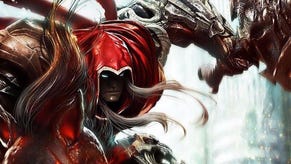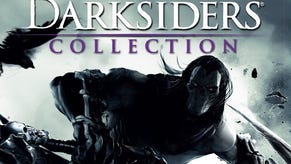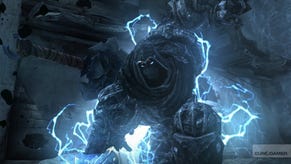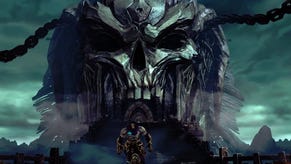Darksiders
Additional revelations.
Ruin has a chargeable dash move. You can just dash repeatedly on-foot, which is handy for evasion, and for getting closer to larger enemies who have thicker armour and attack patterns that only expose them to damage at specific points. It's similar to Link's roll move, and it's safe to say that it's not just this and the horsey that are tugging on the green tunic in the wake of the master, because the more of Darksiders you play, more obvious are the similarities to Zelda. The Twilight Cathedral, home to the bat-queen Tiamat mentioned in our last hands-on, is best thought of as a Zelda dungeon, for instance.
You begin by switching puzzle swords between statues to unlock certain doorways, and stabbing your way through them (yes, in the world of Darksiders, even the keys are swords), and figuring out ways to drop heavy objects onto loose flooring to pop open access to the catacombs. Once down there, you gather the Crossblade, a sort of Klingon equivalent of Link's boomerang, used to slice enemies, but also to solve puzzles - destroying rubble blocking a statue you need to raise from fatal lava, for instance, and transporting sparks from a burning torch bowl to combustible bomb rocks you've thrown onto the sticky exterior of the mentalist bat-queen.
Pick your way into a dungeon, earn a new toy, pick the rest of the way to the boss with its help, zigzagging through common areas with new tools to traverse them. The only difference is that Link doesn't usually rip the wings off the boss's back and flap them about mockingly before reaching into its chest cavity with a massive iron glove and ripping its heart out. Darksiders even has its own four-note "you've just unlocked something" jingle, and collectable heart shards to expand your health capacity.

Besides the Crossblade, other abilities include demonic wings, which allow you to hover by holding onto the button after a double-jump, and can be combined with abyssal geyser thingies, or bounce pads in the common tongue, to reach new heights; and the Mask of Shadows, which reveals elements of the level you might otherwise not spot; and Chronomancing, which allows you to manipulate time. But really, we are going to run out of internet sooner or later, and I still need to mention aerial combos, and of course projectile weapons, like the temporary-use rocket launcher thing picked up pre-horsey, which allows you to fire four big, glowing death-rods into various enemies and then pull the other trigger to remote-detonate them.
There's a danger with all this, of course, that developer Vigil's Nintendo-flattery proves feebly derivative, rather than effective, and it's fair to say that while it packs a lot of action and options, and echoes the framework of a Zelda game, most of the things listed above are just hyperviolent extensions of standard action-adventure tools and weapons. But there is a lot of imagination in Darksiders; it already feels like a coherent world, rather than some walls around the blood-letting, and it already has a cast of bonkers enemies, and it even has Mark Hamill playing a faceless demon who lives in your glove and pops out occasionally for a peptalk.
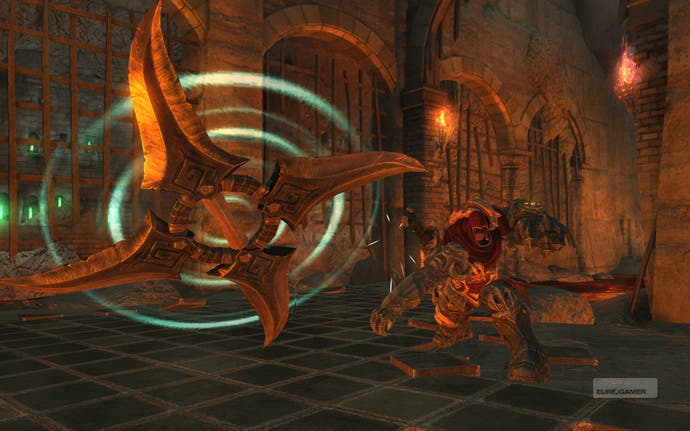
It's wonderfully realised in characterful designs, animations and architecture, skipping along at a fair frame-rate even this far in advance of launch, and it feels extremely solid, with intuitive controls that allow you to flick between different areas of the combat and ability spectrum quickly and efficiently. Enemies are skeletons in armour, flapping monster bats and charging biped rhino death-monsters, all of whom are quickly identified in combat by their appearance, next to which you'll file their patterns and weaknesses with similar speed, just as you might in a Devil May Cry or a God of War or a Zelda, again (sorry). It might not be the sort of THQ game of yesteryear, but in an already strong year for the venerable publisher, it could well be among the strongest.
Darksiders: Wrath of War is due out at the start of 2010 on PS3 and Xbox 360.


